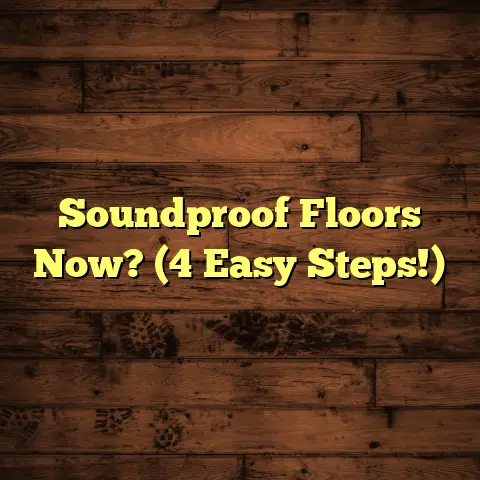Heated Bath Floors: Cost Breakdown? (1 Day Only!)
And let me tell you, one thing that consistently wows homeowners is heated bathroom floors.
Think about it: stepping onto toasty tiles on a chilly morning? Pure bliss! But let’s get real: what’s the actual cost of this luxury?
That’s what we’re diving into today. We’ll break down every aspect of the cost, from initial installation to long-term savings, so you can make an informed decision.
Introduction: The Hidden Benefits of Heated Bath Floors
Heated bathroom floors aren’t just about pampering your toes. They offer a surprising range of benefits that often get overlooked. Let’s uncover some of these hidden perks.
1. Increased Comfort and Warmth
Okay, this one’s obvious, but it’s worth emphasizing. There’s nothing quite like stepping out of a warm shower or bath onto a floor that’s equally inviting.
No more tiptoeing across icy tiles! Heated floors transform your bathroom into a cozy sanctuary.
It’s especially amazing during those cold winter months!
2. Energy Efficiency
This is where things get interesting. You might think heated floors are energy hogs, but they can actually be quite efficient.
Unlike traditional heating systems that blast hot air, heated floors provide radiant heat. Radiant heat warms objects (including you!) directly, instead of just heating the air.
This means you can often set your thermostat lower and still feel comfortable. Plus, many systems come with programmable thermostats, so you can customize the heating schedule to match your routine.
3. Improved Aesthetics
Radiators? Bulky baseboard heaters? Not exactly design-friendly. Heated floors offer a sleek, minimalist alternative.
By eliminating the need for these traditional heating elements, you free up valuable wall space and create a cleaner, more modern look.
This gives you more freedom to design the bathroom of your dreams!
4. Health Benefits
Heated floors can be more than just a luxury for some people. The gentle, consistent warmth can help alleviate symptoms of arthritis and improve circulation.
This is especially beneficial for older adults or anyone with chronic pain conditions. Always consult with your doctor if you have any health concerns.
5. Reduced Mold and Mildew Growth
Bathrooms are notorious for moisture. And moisture loves mold and mildew.
Heated floors help combat this by keeping the floor surface warm and dry. This reduces the chance of moisture accumulating, making it harder for mold and mildew to thrive.
It is particularly beneficial in humid environments.
6. Increased Home Value
Let’s face it: everyone loves a luxurious bathroom. Installing heated floors can be a smart investment that increases your home’s appeal to potential buyers.
It’s a feature that screams “modern” and “comfortable.”
Think of it as an investment in your comfort and your home’s future value!
Body of the Article: Cost Breakdown of Heated Bath Floors
Alright, let’s get down to the nitty-gritty: the cost. We’ll break this down into several key areas to give you a comprehensive picture.
1. Initial Installation Costs
This is the big one. The initial installation costs are determined by several factors, including the type of system, the size of your bathroom, and the complexity of the installation.
Electrical vs. Hydronic:
There are two main types of heated floor systems: electrical and hydronic.
-
Electrical Systems: These use electric heating cables or mats embedded in the floor. They’re generally easier and less expensive to install, making them a popular choice for smaller bathrooms.
-
Hydronic Systems: These circulate hot water through pipes under the floor. They’re more efficient for larger areas, but the installation is more complex and costly.
Base Price:
- Electrical: Expect to pay between \$8 and \$20 per square foot for the materials alone.
- Hydronic: The cost for hydronic systems can range from \$15 to \$35 per square foot for materials.
Materials Costs:
- Heating Element (Electrical): \$8 – \$20 per square foot
- Heating Element (Hydronic): \$15 – \$35 per square foot
- Thermostat: \$100 – \$300 (programmable thermostats are more expensive)
- Insulation: \$1 – \$3 per square foot (essential for efficiency)
- Mortar/Thin-set: \$30 – \$50 per bag
- Self-Leveling Underlayment (Optional): \$2 – \$5 per square foot
- Floor Covering (Tile, Stone, etc.): Varies widely depending on the material
Labor Costs:
Labor costs can vary significantly depending on your location and the complexity of the job. On average, expect to pay between \$5 and \$15 per square foot for installation.
- Electrical: \$5 – \$12 per square foot
- Hydronic: \$8 – \$15 per square foot
Installation Timeline:
Electrical systems are generally quicker to install, typically taking 1-3 days for a standard-sized bathroom. Hydronic systems can take 3-5 days due to the more complex plumbing involved.
Factors Influencing Pricing:
- Bathroom Size: Larger bathrooms require more materials and labor, increasing the overall cost.
- Floor Type: Tile and stone are the most common choices for heated floors. The cost of the flooring material itself will impact the total project cost.
- System Choice: As mentioned earlier, hydronic systems are generally more expensive to install than electrical systems.
- Subfloor Preparation: If your subfloor is uneven or damaged, it may need to be repaired or replaced before installing the heating system, adding to the cost.
- Existing Plumbing (Hydronic): If you’re installing a hydronic system, you’ll need to tie it into your existing plumbing. This can add to the complexity and cost of the installation.
Example:
Let’s say you have a 50-square-foot bathroom and you’re opting for an electrical system with tile flooring.
- Materials:
- Heating element: 50 sq ft x \$12/sq ft = \$600
- Thermostat: \$150
- Insulation: 50 sq ft x \$2/sq ft = \$100
- Mortar: \$40
- Tile: 50 sq ft x \$5/sq ft = \$250
- Labor:
- 50 sq ft x \$8/sq ft = \$400
- Total: \$600 + \$150 + \$100 + \$40 + \$250 + \$400 = \$1540
I always recommend getting multiple quotes from qualified contractors! This allows you to compare pricing and ensure you’re getting the best value for your money.
2. Operating Costs
Okay, you’ve got your heated floors installed. Now, how much is it going to cost to keep those toes toasty?
Average Energy Usage:
The average energy usage of heated floors depends on several factors, including the size of the area, the type of system, the insulation, and your usage habits.
- Electrical Systems: On average, electrical systems consume about 12 watts per square foot.
- Hydronic Systems: Hydronic systems are generally more efficient, but the exact energy usage depends on the efficiency of your boiler or water heater.
Calculating Cost:
To estimate your monthly operating costs, you’ll need to know your electricity rate (or gas rate for hydronic systems).
- Electrical:
- Let’s say your electricity rate is \$0.15 per kilowatt-hour (kWh).
- A 50-square-foot bathroom using 12 watts per square foot consumes 600 watts (0.6 kW).
- If you run the system for 4 hours per day, that’s 2.4 kWh per day.
- Your daily cost is 2.4 kWh x \$0.15/kWh = \$0.36
- Your monthly cost is \$0.36/day x 30 days = \$10.80
Comparison of Heating Systems:
- Electrical: Less efficient than hydronic but often cheaper to install.
- Hydronic: More efficient for larger areas, but requires a boiler or water heater.
Efficiency Ratings:
Look for systems with high energy efficiency ratings. Programmable thermostats can also help you save money by allowing you to customize the heating schedule.
Statistics on Energy Bills:
According to a study by WarmlyYours, heated floors typically add between \$5 and \$20 per month to your energy bill, depending on usage and climate.
Remember, these are just estimates! Your actual costs may vary.
3. Maintenance Costs
Like any mechanical system, heated floors require some maintenance to ensure they operate efficiently and reliably.
Electrical Systems:
Electrical systems are generally low-maintenance. The heating cables are embedded in the floor, so there’s not much to do.
- Maintenance:
- Check the thermostat regularly to ensure it’s functioning properly.
- Inspect the floor for any signs of damage.
Hydronic Systems:
Hydronic systems require more maintenance due to the plumbing involved.
- Maintenance:
- Have your boiler or water heater serviced regularly.
- Check for leaks in the piping.
- Consider a yearly professional inspection.
Longevity and Repair Costs:
- Electrical: Electrical systems can last for 20-25 years with proper installation. Repair costs are typically low, but if a cable fails, it can be difficult to repair without removing the flooring.
- Hydronic: Hydronic systems can last for 30-40 years. Repair costs can be higher due to the complexity of the plumbing.
Warranties:
Most manufacturers offer warranties on their heated floor systems. Be sure to read the warranty carefully to understand what’s covered.
- Typical Coverage:
- Heating element failure
- Thermostat malfunction
- Defects in materials or workmanship
I always recommend keeping your warranty information in a safe place!
4. Comparative Costs
How do heated floors stack up against traditional heating methods? Let’s take a look.
Heated Floors vs. Radiators/Baseboard Heaters:
- Initial Cost: Heated floors are generally more expensive to install than radiators or baseboard heaters.
- Operating Cost: Heated floors can be more energy-efficient in the long run, especially if you use a programmable thermostat.
- Aesthetics: Heated floors are much more aesthetically pleasing, as they eliminate the need for bulky heating elements.
- Comfort: Heated floors provide more consistent and even heat compared to radiators or baseboard heaters.
Long-Term Financial Benefits:
- Energy Savings: Over time, the energy savings from heated floors can offset the higher initial cost.
- Home Value Increase: As mentioned earlier, heated floors can increase your home’s value, making it a worthwhile investment.
Let’s consider an example:
Suppose that the cost of the heated floor is \$1540.
Suppose the total cost of a radiator is \$600.
Suppose the savings per month is \$10.
The breakeven period is 94 months or 7.83 years.
5. Cost Variability by Region
The cost of heated floors can vary significantly depending on your geographic location.
Installation Costs:
Labor costs are generally higher in urban areas and regions with a high cost of living. Material costs can also vary depending on local suppliers.
Operating Costs:
Electricity and gas rates vary widely across the country. In areas with high energy costs, the operating costs of heated floors will be higher.
Examples of Regional Pricing:
- New York City: Expect to pay a premium for both materials and labor due to the high cost of living.
- Rural Midwest: Labor costs are generally lower, but material costs may be higher due to limited availability.
Climate Impact:
In colder climates, you’ll likely use your heated floors more often, resulting in higher operating costs. However, the comfort benefits may outweigh the additional expense.
I advise getting quotes from local contractors to get an accurate estimate for your region!
6. Financing and Budgeting Options
If you’re concerned about the upfront cost of heated floors, there are several financing and budgeting options available.
Financing Options:
- Home Equity Loan: Use the equity in your home to finance the project.
- Personal Loan: Unsecured loans with fixed interest rates.
- Credit Card: Use a credit card with a low interest rate or a 0% introductory offer.
Budget-Friendly Alternatives:
- Install in a Small Area: Focus on heating a small area, such as the space in front of the vanity or shower.
- DIY Installation: If you’re comfortable with electrical or plumbing work, you can save money by installing the system yourself (but be sure to follow all safety precautions!).
- Incremental Installation: Install the heating system now and add the flooring later to spread out the cost.
I recommend exploring all your options and choosing the financing plan that best fits your budget!
Conclusion: The Value Proposition of Heated Bath Floors
So, there you have it: a comprehensive breakdown of the cost of heated bathroom floors. While there’s definitely an upfront investment involved, the hidden benefits – comfort, energy efficiency, aesthetics, health benefits, and increased home value – make them a worthwhile consideration for many homeowners.
Think about it: stepping into your bathroom and feeling that gentle warmth under your feet. It’s a small luxury that can make a big difference in your daily life.
It’s all about creating a space that feels like a true sanctuary. And that, my friend, is priceless.
Ready to take the plunge? I’m here to help you every step of the way!





